Yuheng Lu
TransBench: Breaking Barriers for Transferable Graphical User Interface Agents in Dynamic Digital Environments
May 23, 2025Abstract:Graphical User Interface (GUI) agents, which autonomously operate on digital interfaces through natural language instructions, hold transformative potential for accessibility, automation, and user experience. A critical aspect of their functionality is grounding - the ability to map linguistic intents to visual and structural interface elements. However, existing GUI agents often struggle to adapt to the dynamic and interconnected nature of real-world digital environments, where tasks frequently span multiple platforms and applications while also being impacted by version updates. To address this, we introduce TransBench, the first benchmark designed to systematically evaluate and enhance the transferability of GUI agents across three key dimensions: cross-version transferability (adapting to version updates), cross-platform transferability (generalizing across platforms like iOS, Android, and Web), and cross-application transferability (handling tasks spanning functionally distinct apps). TransBench includes 15 app categories with diverse functionalities, capturing essential pages across versions and platforms to enable robust evaluation. Our experiments demonstrate significant improvements in grounding accuracy, showcasing the practical utility of GUI agents in dynamic, real-world environments. Our code and data will be publicly available at Github.
Enhancing Complex Instruction Following for Large Language Models with Mixture-of-Contexts Fine-tuning
May 17, 2025Abstract:Large language models (LLMs) exhibit remarkable capabilities in handling natural language tasks; however, they may struggle to consistently follow complex instructions including those involve multiple constraints. Post-training LLMs using supervised fine-tuning (SFT) is a standard approach to improve their ability to follow instructions. In addressing complex instruction following, existing efforts primarily focus on data-driven methods that synthesize complex instruction-output pairs for SFT. However, insufficient attention allocated to crucial sub-contexts may reduce the effectiveness of SFT. In this work, we propose transforming sequentially structured input instruction into multiple parallel instructions containing subcontexts. To support processing this multi-input, we propose MISO (Multi-Input Single-Output), an extension to currently dominant decoder-only transformer-based LLMs. MISO introduces a mixture-of-contexts paradigm that jointly considers the overall instruction-output alignment and the influence of individual sub-contexts to enhance SFT effectiveness. We apply MISO fine-tuning to complex instructionfollowing datasets and evaluate it with standard LLM inference. Empirical results demonstrate the superiority of MISO as a fine-tuning method for LLMs, both in terms of effectiveness in complex instruction-following scenarios and its potential for training efficiency.
Controlled Low-Rank Adaptation with Subspace Regularization for Continued Training on Large Language Models
Oct 22, 2024



Abstract:Large language models (LLMs) exhibit remarkable capabilities in natural language processing but face catastrophic forgetting when learning new tasks, where adaptation to a new domain leads to a substantial decline in performance on previous tasks. In this paper, we propose Controlled LoRA (CLoRA), a subspace regularization method on LoRA structure. Aiming to reduce the scale of output change while introduce minimal constraint on model capacity, CLoRA imposes constraint on the direction of updating matrix null space. Experimental results on commonly used LLM finetuning tasks reveal that CLoRA significantly outperforms existing LoRA subsequent methods on both in-domain and outdomain evaluations, highlighting the superority of CLoRA as a effective parameter-efficient finetuning method with catastrophic forgetting mitigating. Further investigation for model parameters indicates that CLoRA effectively balances the trade-off between model capacity and degree of forgetting.
Open-Vocabulary Point-Cloud Object Detection without 3D Annotation
Apr 03, 2023



Abstract:The goal of open-vocabulary detection is to identify novel objects based on arbitrary textual descriptions. In this paper, we address open-vocabulary 3D point-cloud detection by a dividing-and-conquering strategy, which involves: 1) developing a point-cloud detector that can learn a general representation for localizing various objects, and 2) connecting textual and point-cloud representations to enable the detector to classify novel object categories based on text prompting. Specifically, we resort to rich image pre-trained models, by which the point-cloud detector learns localizing objects under the supervision of predicted 2D bounding boxes from 2D pre-trained detectors. Moreover, we propose a novel de-biased triplet cross-modal contrastive learning to connect the modalities of image, point-cloud and text, thereby enabling the point-cloud detector to benefit from vision-language pre-trained models,i.e.,CLIP. The novel use of image and vision-language pre-trained models for point-cloud detectors allows for open-vocabulary 3D object detection without the need for 3D annotations. Experiments demonstrate that the proposed method improves at least 3.03 points and 7.47 points over a wide range of baselines on the ScanNet and SUN RGB-D datasets, respectively. Furthermore, we provide a comprehensive analysis to explain why our approach works.
PiMAE: Point Cloud and Image Interactive Masked Autoencoders for 3D Object Detection
Mar 14, 2023



Abstract:Masked Autoencoders learn strong visual representations and achieve state-of-the-art results in several independent modalities, yet very few works have addressed their capabilities in multi-modality settings. In this work, we focus on point cloud and RGB image data, two modalities that are often presented together in the real world, and explore their meaningful interactions. To improve upon the cross-modal synergy in existing works, we propose PiMAE, a self-supervised pre-training framework that promotes 3D and 2D interaction through three aspects. Specifically, we first notice the importance of masking strategies between the two sources and utilize a projection module to complementarily align the mask and visible tokens of the two modalities. Then, we utilize a well-crafted two-branch MAE pipeline with a novel shared decoder to promote cross-modality interaction in the mask tokens. Finally, we design a unique cross-modal reconstruction module to enhance representation learning for both modalities. Through extensive experiments performed on large-scale RGB-D scene understanding benchmarks (SUN RGB-D and ScannetV2), we discover it is nontrivial to interactively learn point-image features, where we greatly improve multiple 3D detectors, 2D detectors, and few-shot classifiers by 2.9%, 6.7%, and 2.4%, respectively. Code is available at https://github.com/BLVLab/PiMAE.
Open-Vocabulary 3D Detection via Image-level Class and Debiased Cross-modal Contrastive Learning
Jul 05, 2022

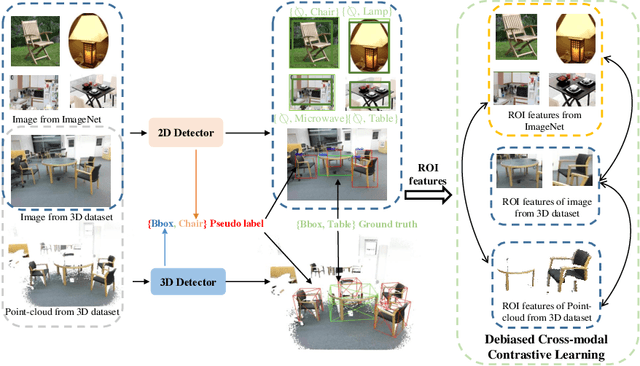

Abstract:Current point-cloud detection methods have difficulty detecting the open-vocabulary objects in the real world, due to their limited generalization capability. Moreover, it is extremely laborious and expensive to collect and fully annotate a point-cloud detection dataset with numerous classes of objects, leading to the limited classes of existing point-cloud datasets and hindering the model to learn general representations to achieve open-vocabulary point-cloud detection. As far as we know, we are the first to study the problem of open-vocabulary 3D point-cloud detection. Instead of seeking a point-cloud dataset with full labels, we resort to ImageNet1K to broaden the vocabulary of the point-cloud detector. We propose OV-3DETIC, an Open-Vocabulary 3D DETector using Image-level Class supervision. Specifically, we take advantage of two modalities, the image modality for recognition and the point-cloud modality for localization, to generate pseudo labels for unseen classes. Then we propose a novel debiased cross-modal contrastive learning method to transfer the knowledge from image modality to point-cloud modality during training. Without hurting the latency during inference, OV-3DETIC makes the point-cloud detector capable of achieving open-vocabulary detection. Extensive experiments demonstrate that the proposed OV-3DETIC achieves at least 10.77 % mAP improvement (absolute value) and 9.56 % mAP improvement (absolute value) by a wide range of baselines on the SUN-RGBD dataset and ScanNet dataset, respectively. Besides, we conduct sufficient experiments to shed light on why the proposed OV-3DETIC works.
Enhancing and Dissecting Crowd Counting By Synthetic Data
Jan 22, 2022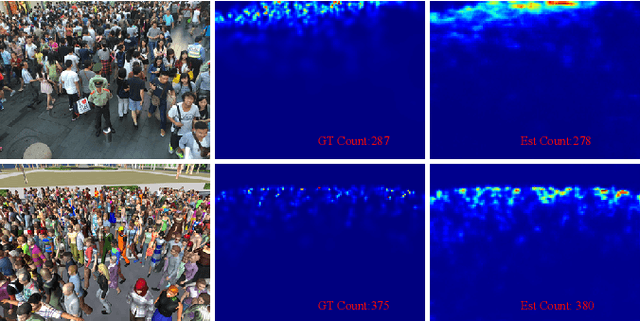
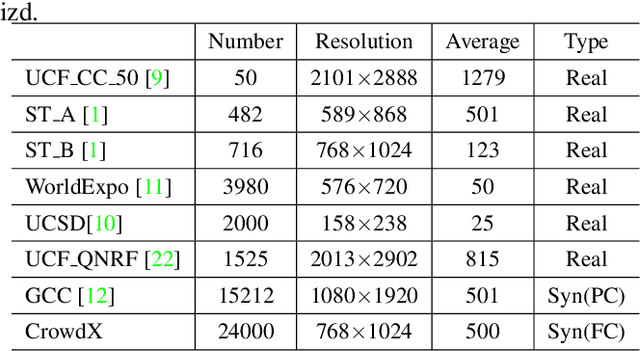


Abstract:In this article, we propose a simulated crowd counting dataset CrowdX, which has a large scale, accurate labeling, parameterized realization, and high fidelity. The experimental results of using this dataset as data enhancement show that the performance of the proposed streamlined and efficient benchmark network ESA-Net can be improved by 8.4\%. The other two classic heterogeneous architectures MCNN and CSRNet pre-trained on CrowdX also show significant performance improvements. Considering many influencing factors determine performance, such as background, camera angle, human density, and resolution. Although these factors are important, there is still a lack of research on how they affect crowd counting. Thanks to the CrowdX dataset with rich annotation information, we conduct a large number of data-driven comparative experiments to analyze these factors. Our research provides a reference for a deeper understanding of the crowd counting problem and puts forward some useful suggestions in the actual deployment of the algorithm.
Graph Neural Netwrok with Interaction Pattern for Group Recommendation
Sep 21, 2021



Abstract:With the development of social platforms, people are more and more inclined to combine into groups to participate in some activities, so group recommendation has gradually become a problem worthy of research. For group recommendation, an important issue is how to obtain the characteristic representation of the group and the item through personal interaction history, and obtain the group's preference for the item. For this problem, we proposed the model GIP4GR (Graph Neural Network with Interaction Pattern For Group Recommendation). Specifically, our model use the graph neural network framework with powerful representation capabilities to represent the interaction between group-user-items in the topological structure of the graph, and at the same time, analyze the interaction pattern of the graph to adjust the feature output of the graph neural network, the feature representations of groups, and items are obtained to calculate the group's preference for items. We conducted a lot of experiments on two real-world datasets to illustrate the superior performance of our model.
Exploiting Path Information for Anchor Based Graph Neural Network
May 09, 2021



Abstract:Learning node representation that incorporating information from graph structure benefits wide range of tasks on graph. Majority of existing graph neural networks (GNNs) have limited power in capturing position information for a given node. The idea of positioning nodes with selected anchors has been exploit, yet mainly rely on explicit labeling of distance information. Here we propose Graph Inference Representation (GIR), an anchor based GNN encoding path information related to anchors for each node. Abilities to get position-aware embedding are theoretically and experimentally investigated on GIRs and its core variants. Further, the complementary characteristic of GIRs and typical GNNs embeddings are demonstrated. We show that GIRs get outperformed results on position-aware scenario, and could improve GNNs results by fuse GIRs embedding.
PIC-Net: Point Cloud and Image Collaboration Network for Large-Scale Place Recognition
Aug 03, 2020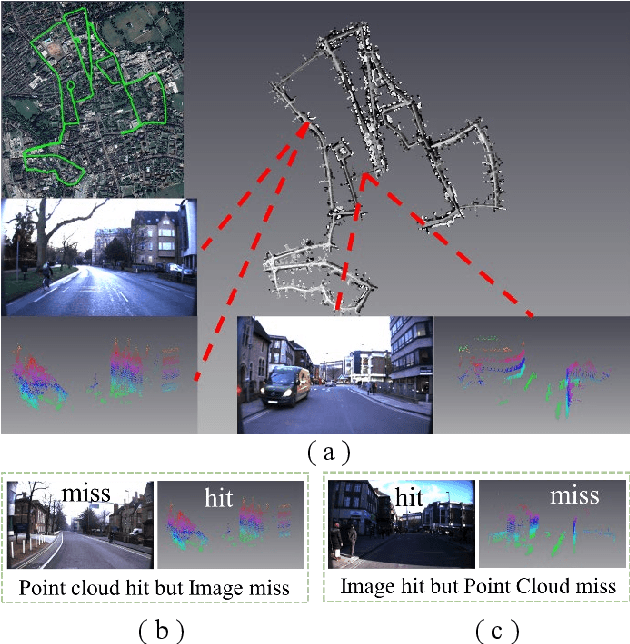


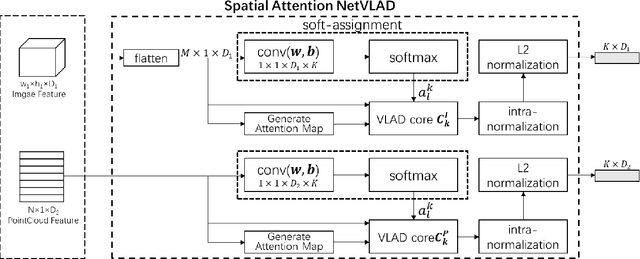
Abstract:Place recognition is one of the hot research fields in automation technology and is still an open issue, Camera and Lidar are two mainstream sensors used in this task, Camera-based methods are easily affected by illumination and season changes, LIDAR cannot get the rich data as the image could , In this paper, we propose the PIC-Net (Point cloud and Image Collaboration Network), which use attention mechanism to fuse the features of image and point cloud, and mine the complementary information between the two. Furthermore, in order to improve the recognition performance at night, we transform the night image into the daytime style. Comparison results show that the collaboration of image and point cloud outperform both image-based and point cloud-based method, the attention strategy and day-night-transform could further improve the performance.
 Add to Chrome
Add to Chrome Add to Firefox
Add to Firefox Add to Edge
Add to Edge